Monitoring System for Railway Infrastructure Elements Based on Thermal Imaging Analysis
Abstract
1. Introduction
2. Literature Analysis
2.1. Rail Defects Detection
- Designers of EOR devices;
- Manufacturers of railway turnouts and manufacturers of EOR devices;
- Contractors implementing the installation of EOR devices;
- Employees of supervision and operation of electric turnout heating devices in PKP Polskie Linie Kolejowe S.A.
2.2. Machine Learning-Based Modelling for Railway Inspection
3. Characteristics of the Tested Object
3.1. EOR Trackside Devices Selected for Analysis and Image Detection Method Using Thermal Imaging
- A heater rod is a metal jacket of the heater with a flat-oval cross-section, resistant to weather conditions, inside which a heating coil electrically isolated from the jacket is placed.
- A 3-wire copper power cable in flexible insulation (sheath) with increased resistance to mechanical damage is suitable for operation in places exposed to grease and temperatures from −40 °C to +70 °C. The wires of the power supply cable should have insulation colour in accordance with PN-EN 60068-2-6:2002: black or brown for the power wire; blue for the neutral wire, yellow and green for the protection wire.
- A hermetic coupler connects the power supply cable with the heater rod.
3.2. Track-Side EOR Equipment Maintenance vs. Thermal Imaging Camera
- (a)
- Determining the extent of wear or damage to EOR devices components;
- (b)
- Carrying out necessary repairs of the devices or replacement of components;
- (c)
- Carrying out measurements of technical parameters (in a one-year cycle—testing of anti-shock protection efficiency of EOR devices, testing of the state of insulation of transformers and EOR transformer boxes, in a five-year cycle—measurements as in the case of the one-year cycle and testing of the state of insulation of power, control and signalling cables, testing of earthing);
- (d)
- Performance of maintenance operations;
- (e)
- Painting, if necessary, identification markings in accordance with the guidelines applicable in national carrier (here PKP Polskie Linie Kolejowe S.A.).
4. Thermographic Testing of EOR Element
4.1. Meteorological Conditions
4.2. Thermovision Imaging od EOR Device
4.3. Digital Representation of Thermograph Imaging
5. Information System Supporting Thermographic Inspection
5.1. System Overview
- Schematic representation of the test object for the recognition of the EOR elements placement;
- Operating temperature range, Table 2;
- Colour palettes e.g., rain, grey, iron;
- Specific operating parameters (temperature), Table 2;
- Interference parameters (temperature);
- Temperature below the values defined in Table 2;
- Symptoms of heater malfunction;
- Set of historic thermograms.
- Manual analysis module;
- Expert analysis module;
- Artificial intelligence module (SVM);
- Cause and safety analysis module.
5.2. The Concept of Machine Learning Applied to Analysis of Thermograms for Fault and Damage Inspection
6. Conclusions
Author Contributions
Funding
Institutional Review Board Statement
Informed Consent Statement
Acknowledgments
Conflicts of Interest
References
- Burdzik, R.; Nowak, B.; Rozmus, J.; Słowiński, P.; Pankiewicz, J. Safety in the railway industry. Arch. Transp. 2017, 44, 15–24. [Google Scholar] [CrossRef]
- Gołębiowski, P.; Kukulski, J. Preliminary study of shaping the railway track geometry in terms of their maintenance costs and capacity. Arch. Transp. 2020, 53, 115–128. [Google Scholar] [CrossRef]
- Urbaniak, M.; Kardas-Cinal, E.; Jacyna, M. Optimization of Energetic Train Cooperation. Symmetry 2020, 11, 1175. [Google Scholar] [CrossRef]
- Sobota, A.; Żochowska, R.; Szczepański, E.; Gołda, P. The influence of tram tracks on car vehicle speed and noise emission at four-approach intersections located on multilane arteries in cities. J. Vibroeng. 2018, 20, 2453–2468. [Google Scholar] [CrossRef]
- Jacyna, M.; Szczepański, E.; Izdebski, M.; Jasiński, S.; Maciejewski, M. Characteristics of event recorders in Automatic Train Control systems. Arch. Transp. 2018, 46, 61–70. [Google Scholar] [CrossRef]
- Design Guidelines for Electrical Turnout Heating Equipment Iet-5; Annex to the Executive Order No. 46/2015 of PKP Polskie Linie Kolejowe S.A. of 27.10.2015 Warsaw 2015. Available online: https://www.plk-sa.pl/files/public/user_upload/pdf/Akty_prawne_i_przepisy/Instrukcje/Podglad/Iet-5.pdf (accessed on 31 May 2021).
- Kowalski, M.; Izdebski, M.; Żak, J.; Gołda, P.; Manerowski, J. Planning and management of aircraft maintenance using a genetic algorithm. Eksploat. Niezawodn. 2021, 23, 143–153. [Google Scholar] [CrossRef]
- Gołda, P. Selected Decision Problems in the Implementation of Airport Operations. Sci. J. Sil. Univ. Technol. Ser. Transp. 2018, 101, 79–88. [Google Scholar] [CrossRef]
- Izdebski, M.; Jacyna, M. An Efficient Hybrid Algorithm for Energy Expenditure Estimation for Electric Vehicles in Urban Service Enterprises. Energies 2021, 14, 2004. [Google Scholar] [CrossRef]
- Żochowska, R.; Jacyna, M.; Kłos, M.J.; Soczówka, P. A GIS-Based Method of the Assessment of Spatial Integration of Bike-Sharing Stations. Sustainability 2021, 13, 3894. [Google Scholar] [CrossRef]
- Luo, Y. A model for predicting the effect of temperature force of continuous welded rail track. Proc. Inst. Mech. Eng. Part F J. Rail Rapid Transit. 1999, 213, 117–124. [Google Scholar] [CrossRef]
- Connell, D. Rail Safety and Rail Life Extension. In Proceedings of the 16th Annual AAR Research Review 2011, Pueblo, CO, USA, 15–16 March 2011; Available online: http://www.railway-research.org/Transportation-Technology-Center (accessed on 4 March 2021).
- Rail Track Inspection Vehicles|Self-Propelled Rail Cars|Hi-Rail Vehicles|ENSCO 2020. Available online: https://www.ensco.com/rail/track-inspection-vehicles (accessed on 4 March 2021).
- Rychlicki, M.; Kasprzyk, Z.; Rosiński, A. Analysis of Accuracy and Reliability of Different Types of GPS Receivers. Sensors 2020, 20, 6498. [Google Scholar] [CrossRef]
- Papaelias, M.P.; Roberts, C.; Davis, C.L. A review on non-destructive evaluation of rails: State-of-the-art and future development. Proc. Inst. Mech. Eng. Part F J. Rail Rapid Transit. 2008, 222, 367–384. [Google Scholar] [CrossRef]
- Bombarda, D.; Vitetta, G.M.; Ferrante, G. Rail Diagnostics Based on Ultrasonic Guided Waves: An Overview. Appl. Sci. 2021, 11, 1071. [Google Scholar] [CrossRef]
- Kenderian, S.; Djordjevic, B.B.; Green, R.E. Laser based and air coupled ultrasound as noncontact and remote techniques for testing of railroad tracks. Mater. Eval. 2002, 60, 65–70. [Google Scholar]
- Berry, A.; Nejikovsky, B.; Gibert, X.; Tajaddini, A. High Speed Video Inspection of Joint Bars Using Advanced Image Collection and Processing Techniques. In Proceedings of the Conference Presentation: World Congress on Railway Research, Seoul, Korea, 18–22 May 2008. [Google Scholar]
- Yuan, Z.; Zhu, S.; Yuan, X.; Zhai, W. Vibration-based damage detection of rail fastener clip using convolutional neural network: Experiment and simulation. Eng. Fail. Anal. 2021, 119, 104906. [Google Scholar] [CrossRef]
- Flis, M. Contactless turnouts’ heating for energy consumption optimization. Arch. Electr. Eng. 2020, 69, 133–145. [Google Scholar]
- Flis, M. Energy efficiency analysis of railway turnout heating system with a melting snow model heated by classic and contactless heating method. Arch. Electr. Eng. 2019, 68, 511–520. [Google Scholar]
- Wołoszyn, M.; Jakubiuk, K.; Flis, M. Analysis of resistive and inductive heating of railway turnouts. Przegląd. Elektrotechniczny 2016, 4, 54–57. [Google Scholar] [CrossRef][Green Version]
- Usamentiaga, R.; Sfarra, S.; Fleuret, J.; Yousefi, B.; García, D.F. Rail inspection using active thermography to detect rolled-in material. In Proceedings of the 2018 International Conference on Quantitative InfraRed Thermography, Berlin, Germany, 25–29 June 2018. [Google Scholar] [CrossRef]
- Oswald-Tranta, B. Induction Thermography for Surface Crack Detection and Depth Determination. Appl. Sci. 2018, 8, 257. [Google Scholar] [CrossRef]
- Netzelmann, U.; Walle, G.; Lugin, S.; Ehlen, A.; Bessert, S.; Valeske, B. Induction thermography: Principle, applications and first steps towards standardization. Quant. Infrared Thermogr. J. 2016, 13, 170–181. [Google Scholar] [CrossRef]
- Schlichting, J.; Ziegler, M.; Dey, A.; Maierhofer, C.; Kreutzbruck, M. Efficient data evaluation for thermographic crack detection. Qirt J. 2011, 8, 119–123. [Google Scholar] [CrossRef]
- Flis, M. Analiza porównawcza 2D i 3D klasycznego i bezstykowego elektrycznego ogrzewania rozjazdów kolejowych. Pozn. Univ. Technol. Acad. J. Electr. Eng. 2016, 88, 301–311. [Google Scholar]
- Kędra, Z. Diagnostyka obrazowa rozjazdów kolejowych. Drog. Bud. Infrastrukt. 2012, 3, 47–51. [Google Scholar]
- Operating and Maintenance Manual for Iet-1 Electric Turnout Heating Equipment; Annex to the Executive Order No. 26/2007 of PKP Polskie Linie Kolejowe S.A. of 07 November 2007 Warsaw 2014. Available online: https://www.plk-sa.pl/files/public/user_upload/pdf/Akty_prawne_i_przepisy/Instrukcje/Podglad/Instrukcja_eksploatacji_i_utrzymania_urzadzen_elektrycznego_ogrzewania_rozjazdow_Iet-1...pdf (accessed on 31 May 2021).
- Normative Document 01-8/ET/2008. Heaters for Electric Heating of Turnouts Iet-118; Annex No. 6 to the Executive Order No. 2/2009 of PKP Polskie Linie Kolejowe S.A. of 2 March 2009 Warsaw 2008. Available online: https://www.plk-sa.pl/files/public/user_upload/pdf/Akty_prawne_i_przepisy/Instrukcje/Wydruk/Iet/let-118_WCAG.pdf (accessed on 31 May 2021).
- Shafiullah, G.M.; Shawkat, A.; Thompson, A.; Wolfs, P. Predicting Vertical Acceleration of Railway Wagons Using Regression Algorithms. IEEE Trans. Intell. Transp. Syst. 2010, 11, 290–299. [Google Scholar] [CrossRef]
- Muhamedyev, R. Machine learning methods: An overview. Comput. Model. New Technol. 2015, 19, 14–29. [Google Scholar]
- Yang, C.; Sun, Y.; Ladubec, C.; Liu, Y. Developing Machine Learning-Based Models for Railway Inspection. Appl. Sci. 2021, 11, 13. [Google Scholar] [CrossRef]
- LeCun, Y.; Bengio, Y.; Hinton, G. Deep learning. Nature 2015, 521, 436–444. [Google Scholar] [CrossRef] [PubMed]
- Schmidhuber, J. Deep learning in neural networks: An overview. Neural Netw. 2015, 61, 85–117. [Google Scholar] [CrossRef] [PubMed]
- Zheng, S.; Cornelissen, L.J.; Cui, X.; Jing, X.; Veldhuis, R.N.J.; Oudkerk, M.; van Ooijen, P.M.A. Deep convolutional neural networks for multiplanar lung nodule detection: Improvement in small nodule identification. Med. Phys. 2018, 48, 733–744. [Google Scholar] [CrossRef]
- Cheng, C.; Lia, C.; Hana, Y.; Zhu, Y. Semi-supervised deep learning image caption model based on Pseudo Label and N-gram. Int. J. Approx. Reason. 2021, 131, 93–107. [Google Scholar] [CrossRef]
- Wang, P.; Fan, E.; Wang, P. Comparative analysis of image classification algorithms based on traditional machine learning and deep learning. Pattern Recognit. Lett. 2021, 141, 61–67. [Google Scholar] [CrossRef]
- Technical Conditions for Railroad Surface Maintenance on Railway Lines Id-1 (D-1); Annex No. 1 to the Executive Order No. 14/2005 of PKP Polskie Linie Kolejowe S.A. of 18 May 2005 Warsaw 2005. Available online: https://www.plk-sa.pl/files/public/user_upload/pdf/Akty_prawne_i_przepisy/Instrukcje/Wydruk/Warunki_techniczne_Id-1_ujednolic..pdf (accessed on 31 May 2021).
- Klein, L. Sensor and Data Fusion: A Tool for Information Assessment and Decision Making; SPIE Press Monograph Vol. PM138SC; Reprint Edition; SPIE Press: Bellingham, WA, USA, 2004; ISBN 10: 0819483281/13: 978-0819483287. [Google Scholar]
- Lupolova, N.; Dallman, T.J.; Matthews, L.; Bono, J.L.; Gally, D.L. Support vector machine applied to predict the zoonotic potential of E. coli O157 cattle isolates. Proc. Natl. Acad. Sci. USA 2016, 113, 11312–11317. [Google Scholar] [CrossRef] [PubMed]
- Malachowski, J.; Ziolkowski, J.; Szkutnik-Rogoz, J.; Legas, A.; Oszczypala, M. Application of the Bloch-Schmigalla Method to Optimize the Organization of the Process of Repairing Unmanned Ground Vehicles. Adv. Sci. Technol. Res. J. 2020, 14, 39–48. [Google Scholar] [CrossRef]
- Xu, M. Image processing system based on FPGA and convolutional neural network. Microprocess. Microsyst. 2020, 103379, in press. [Google Scholar] [CrossRef]
- Udendhran, R.; Balamurugan, M.; Suresh, A.; Varatharajan, R. Enhancing image processing architecture using deep learning for embedded vision systems. Microprocess. Microsyst. 2020, 76, 103094. [Google Scholar] [CrossRef]
- Chen, W.; Wang, W.; Wang, K.; Li, Z.; Li, H.; Liu, S. Lane departure warning systems and lane line detection methods based on image processing and semantic segmentation: A review. J. Traffic Transp. Eng. 2020, 7, 748–774. [Google Scholar] [CrossRef]
- Van Engelen, J.E.; Hoos, H.H. A survey on semi-supervised learning. Mach. Learn. 2020, 109, 373–440. [Google Scholar] [CrossRef]
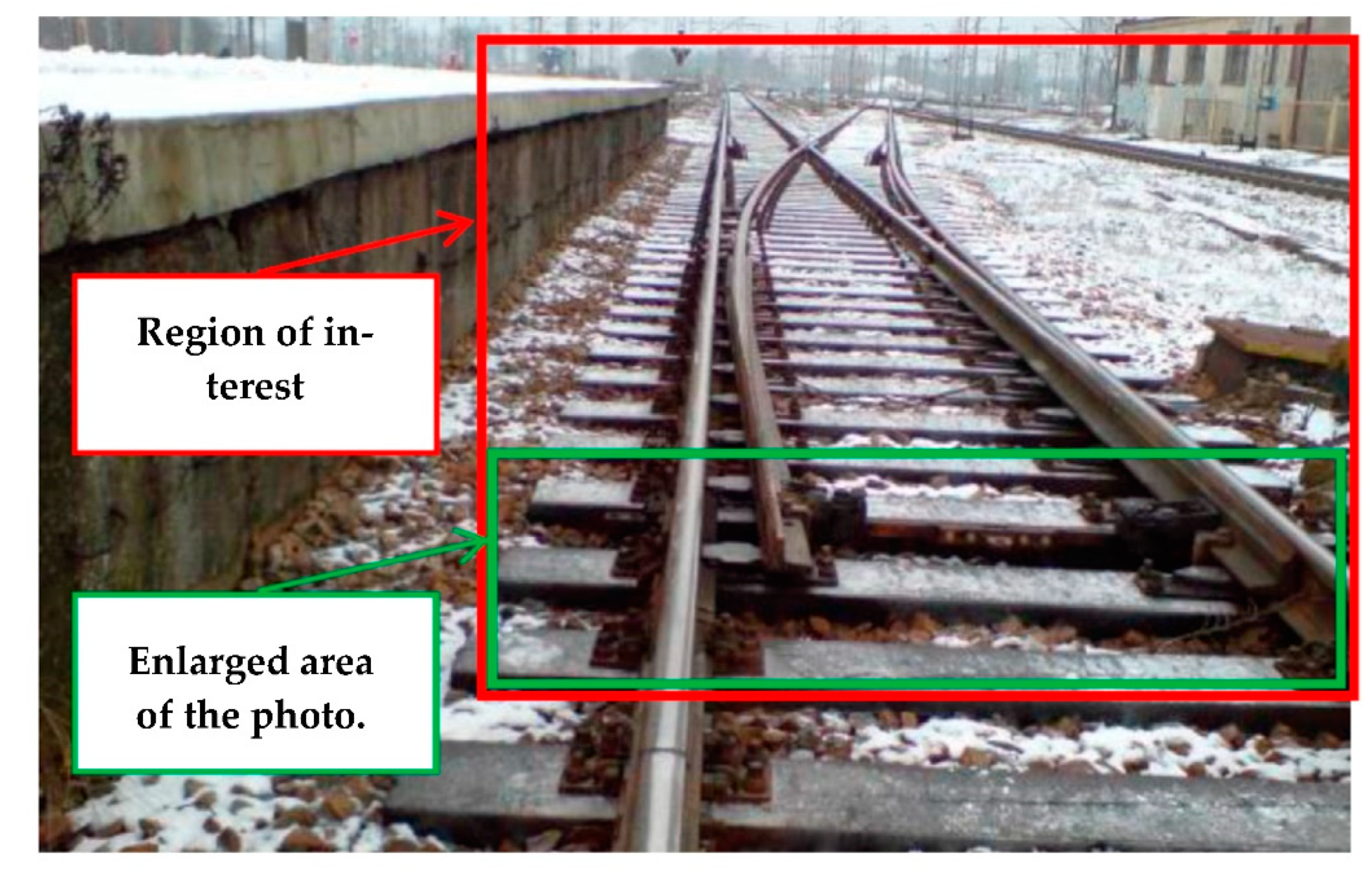
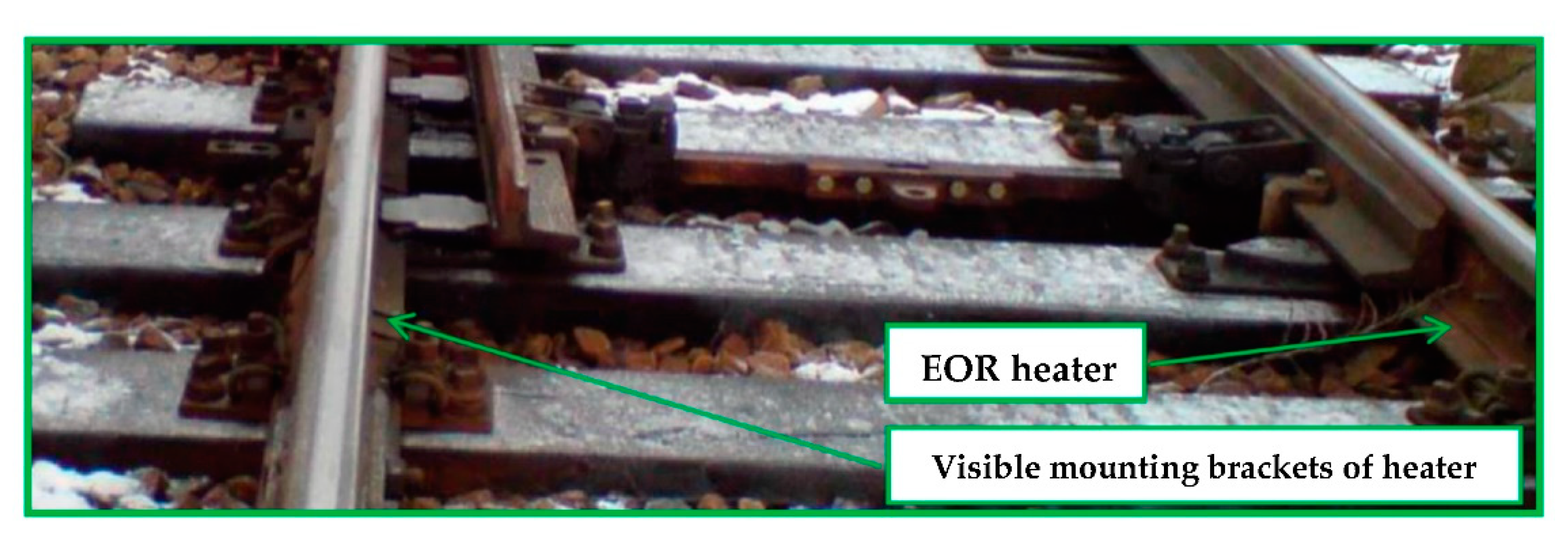
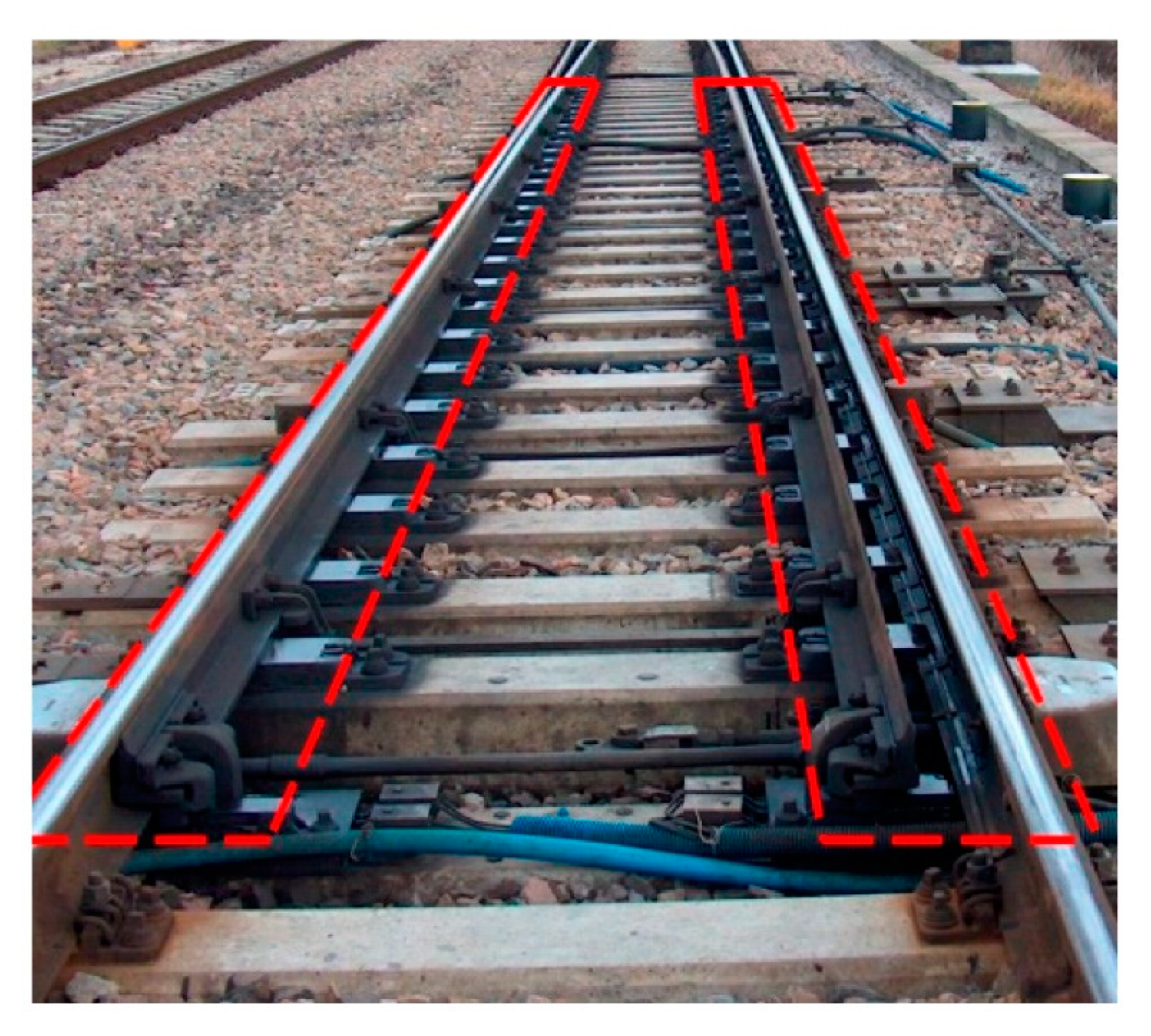


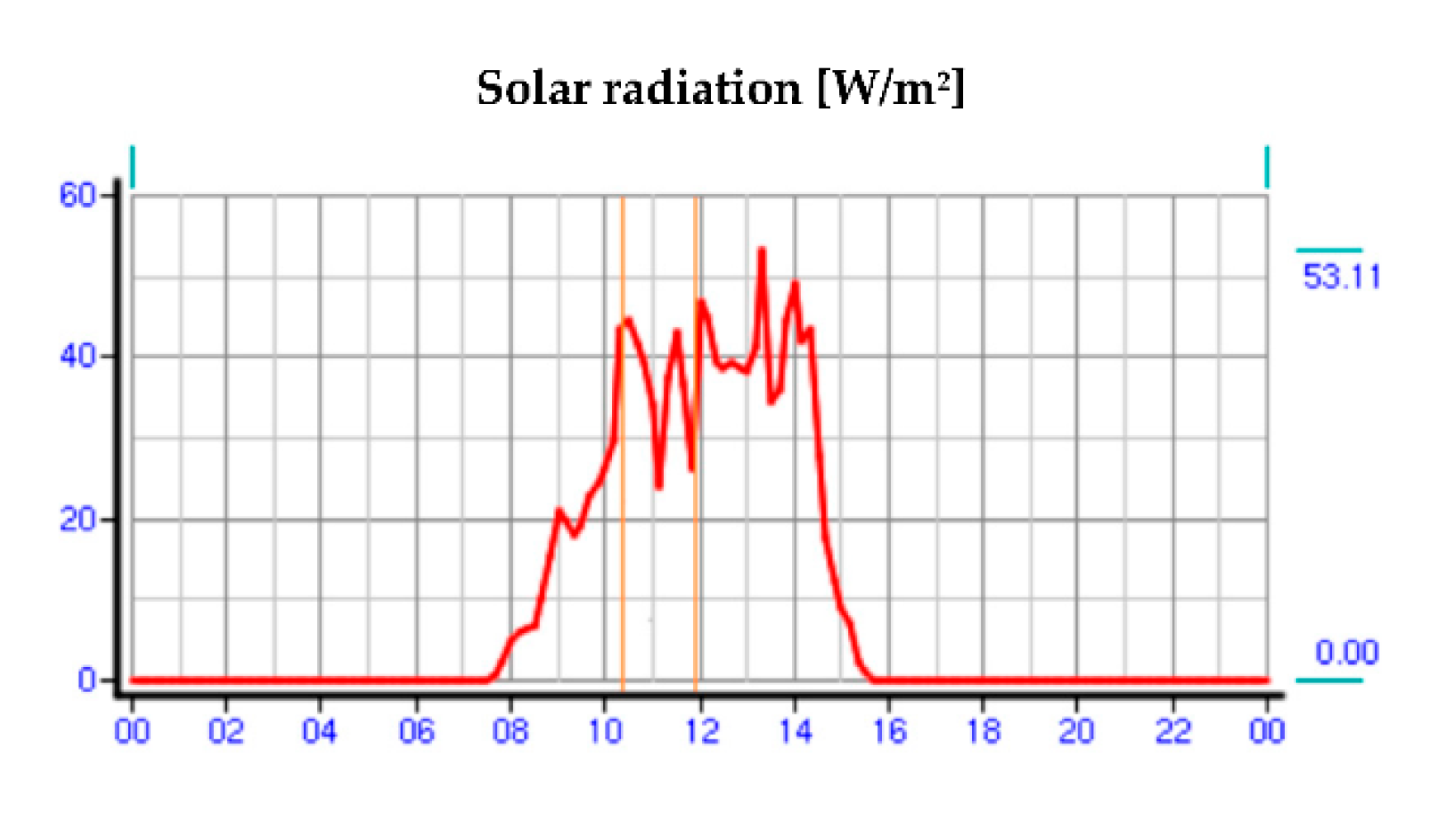

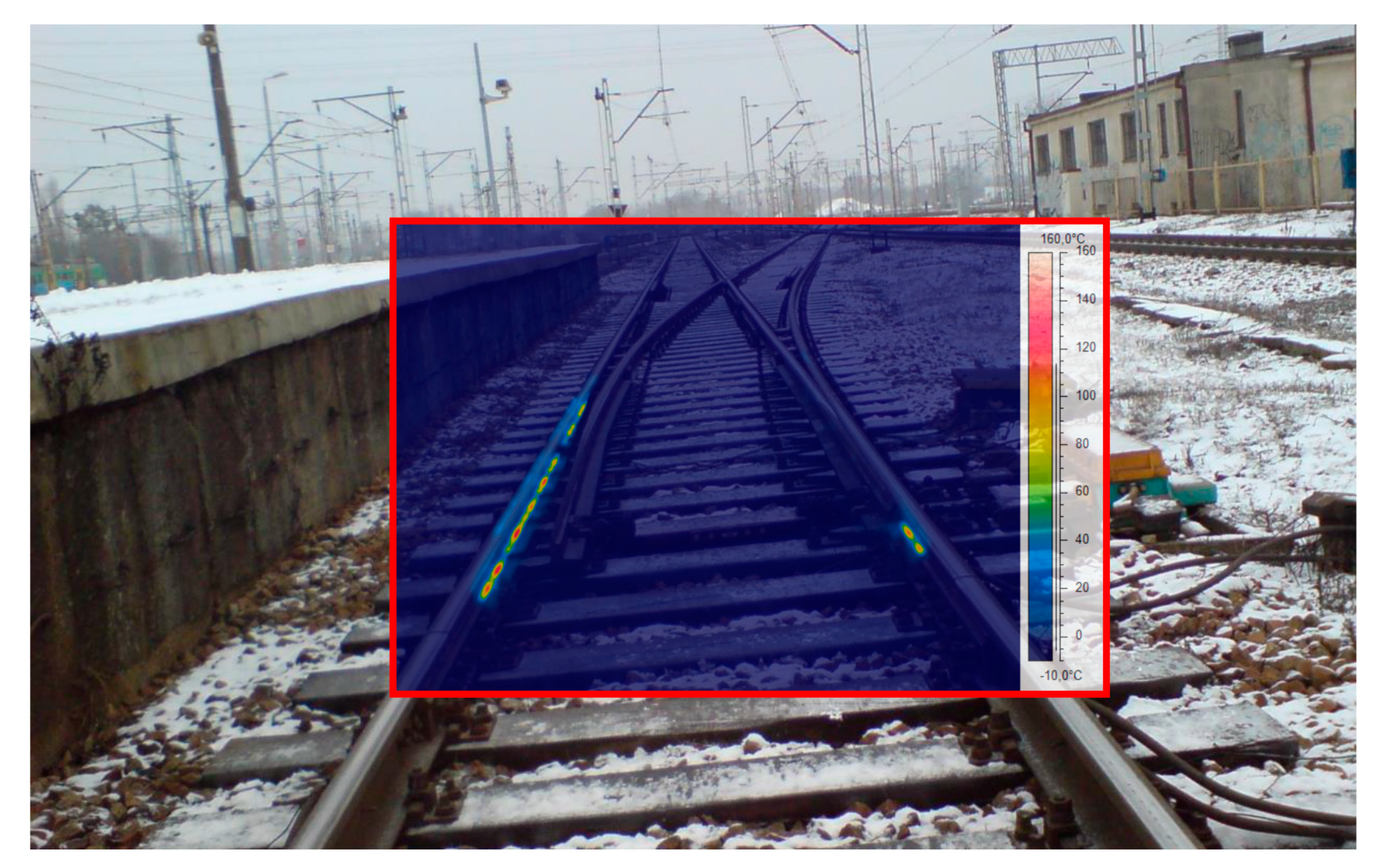
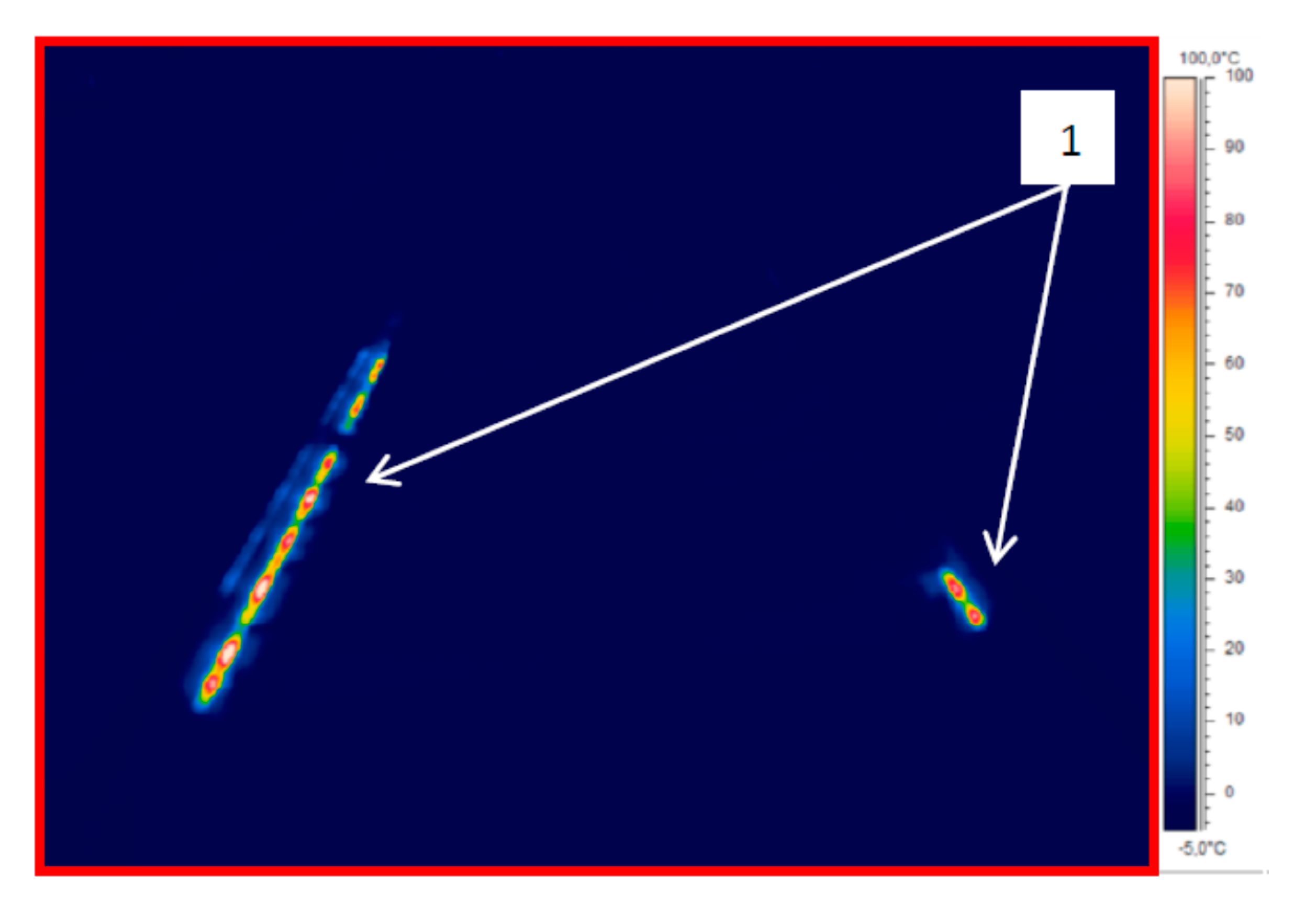

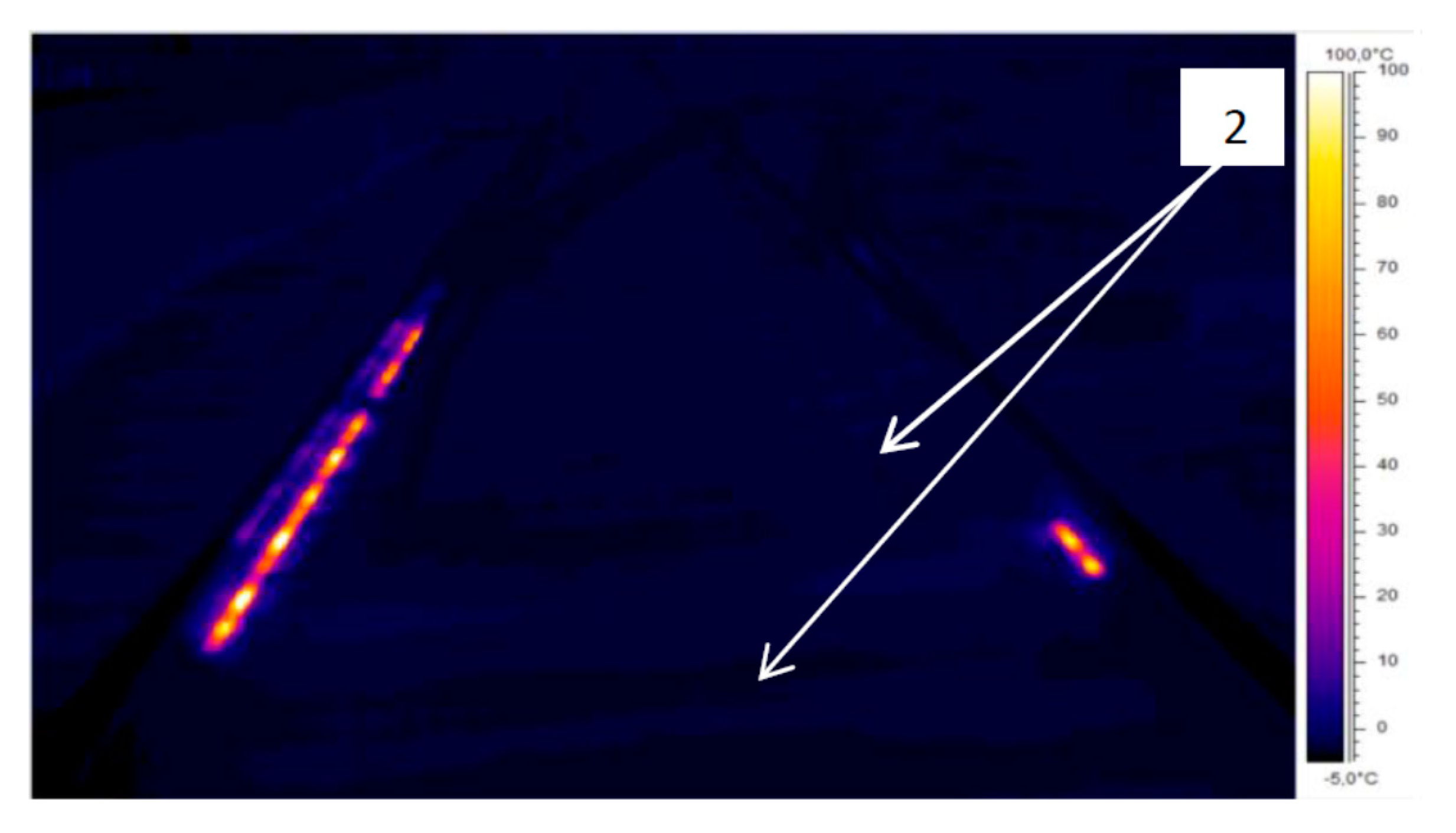
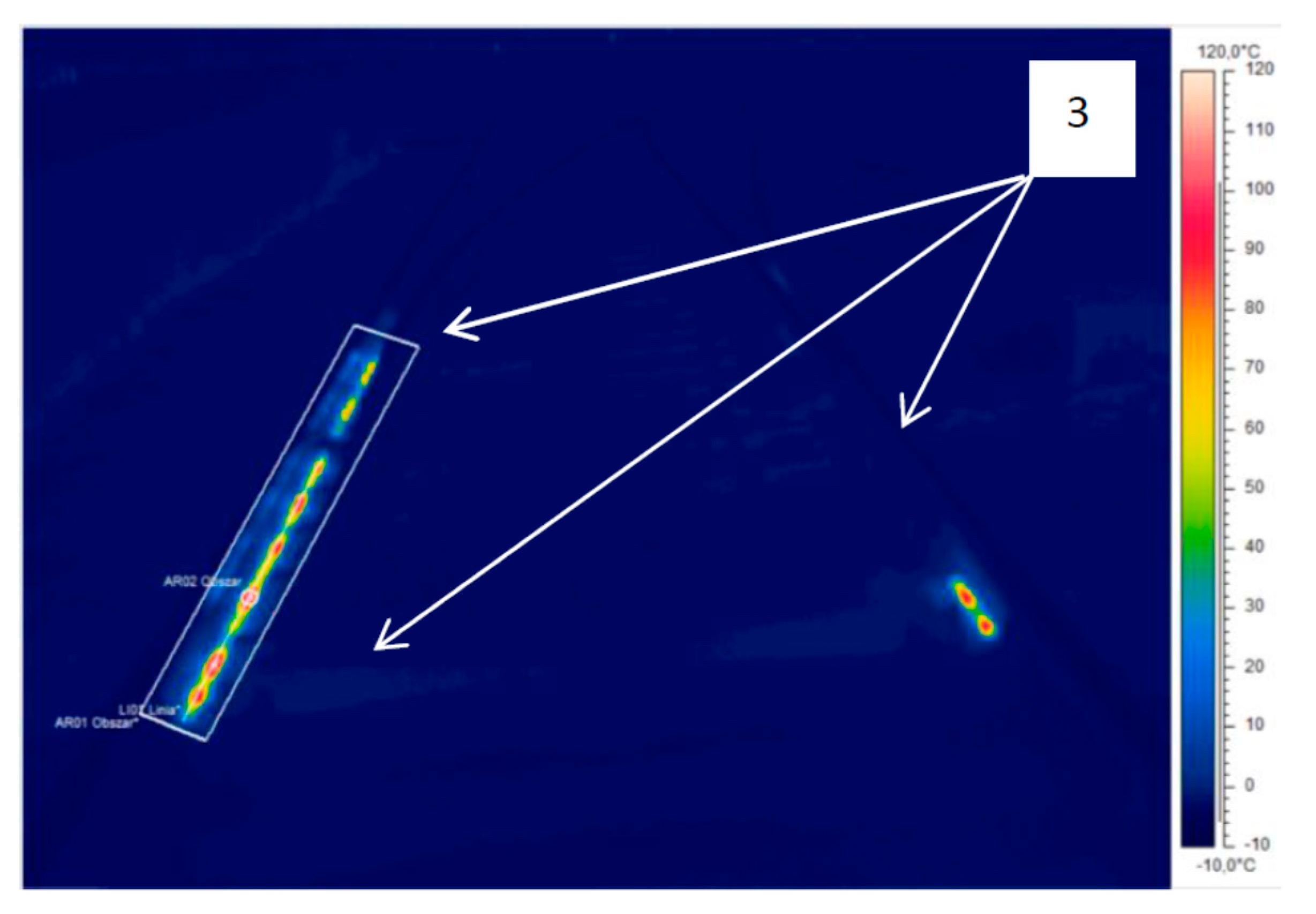
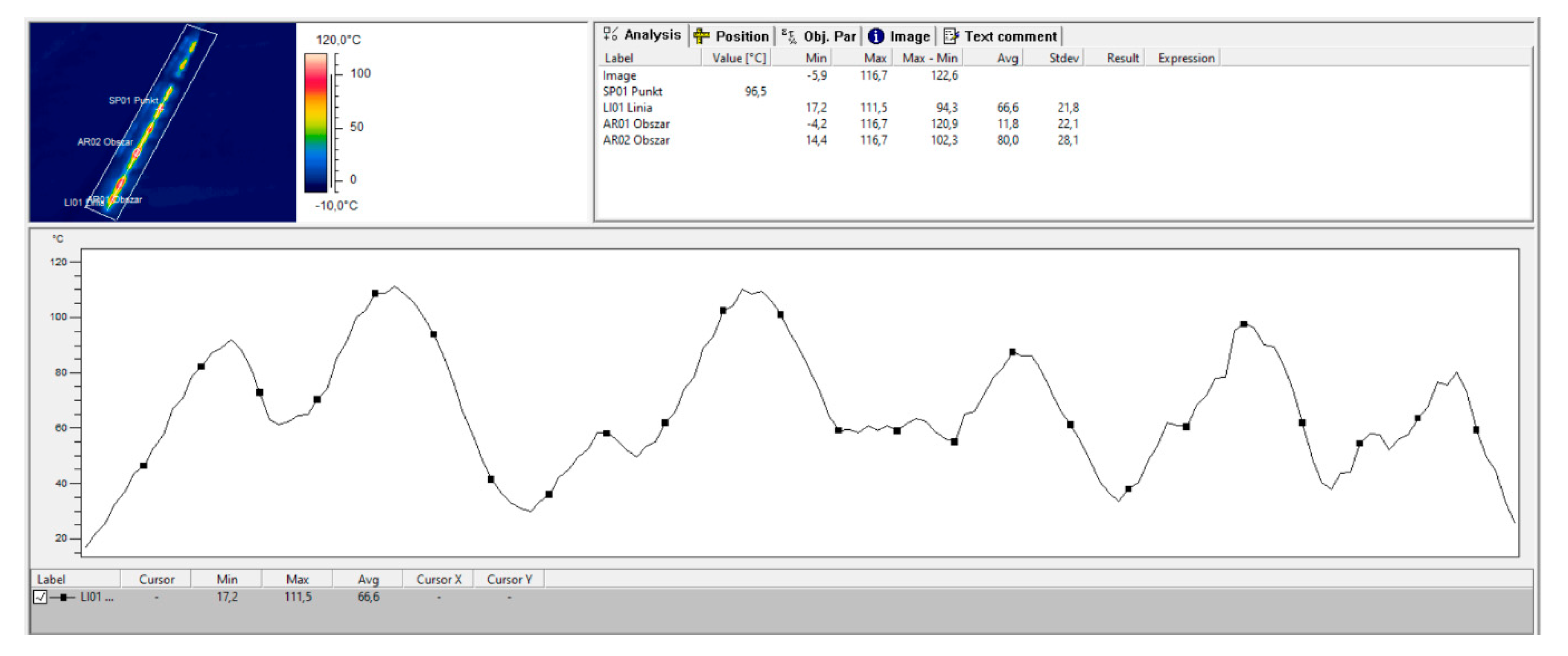
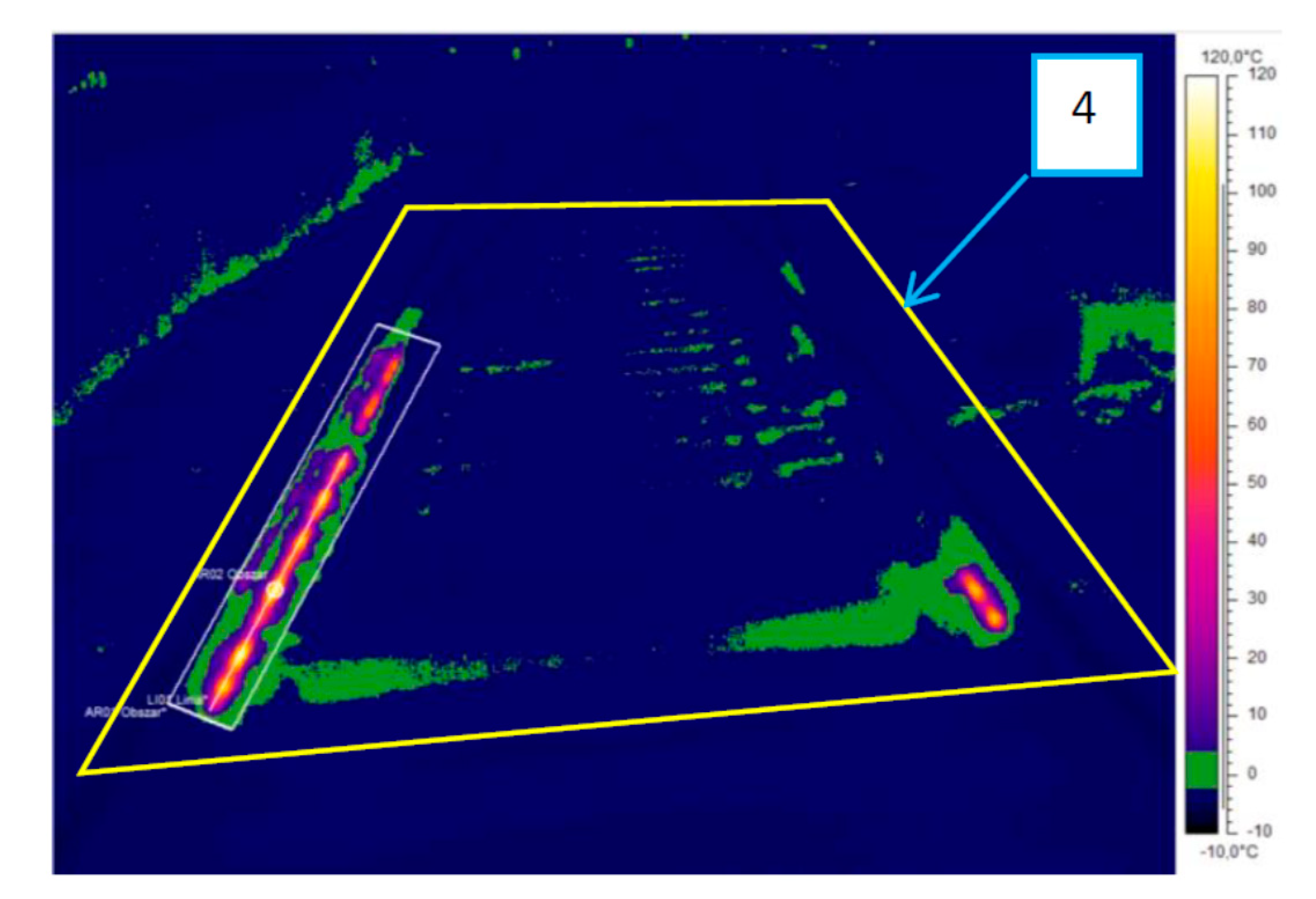
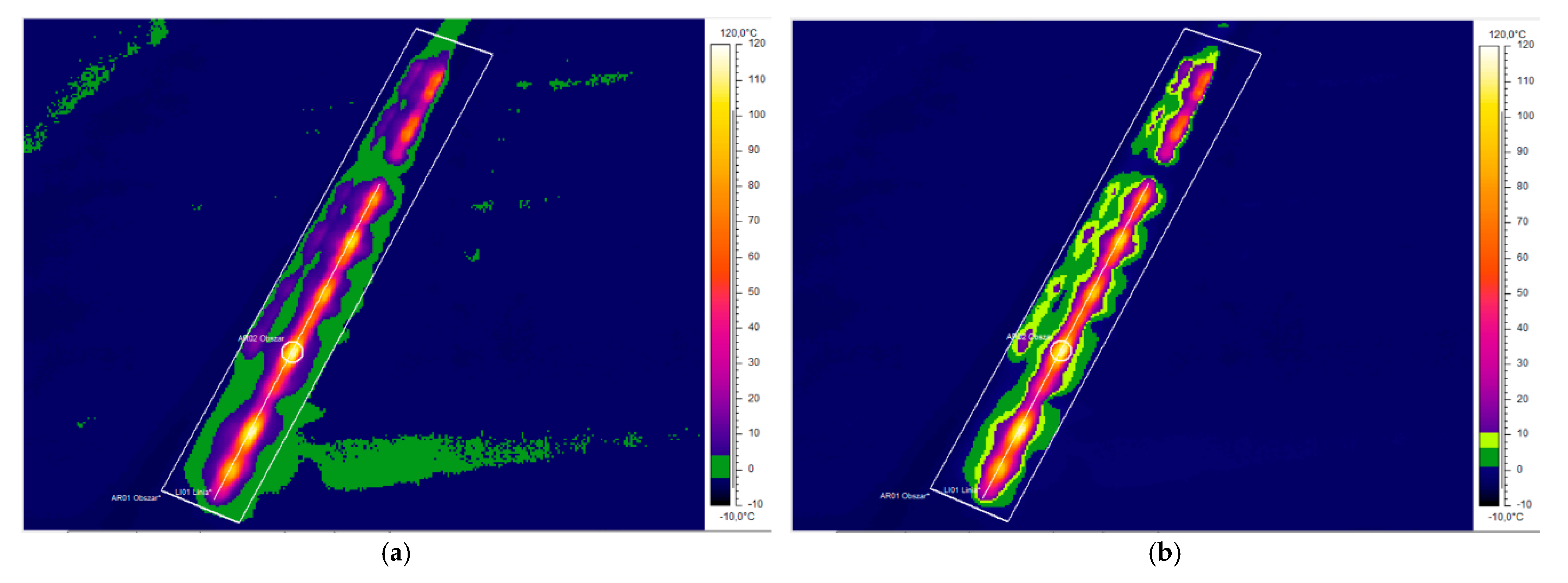
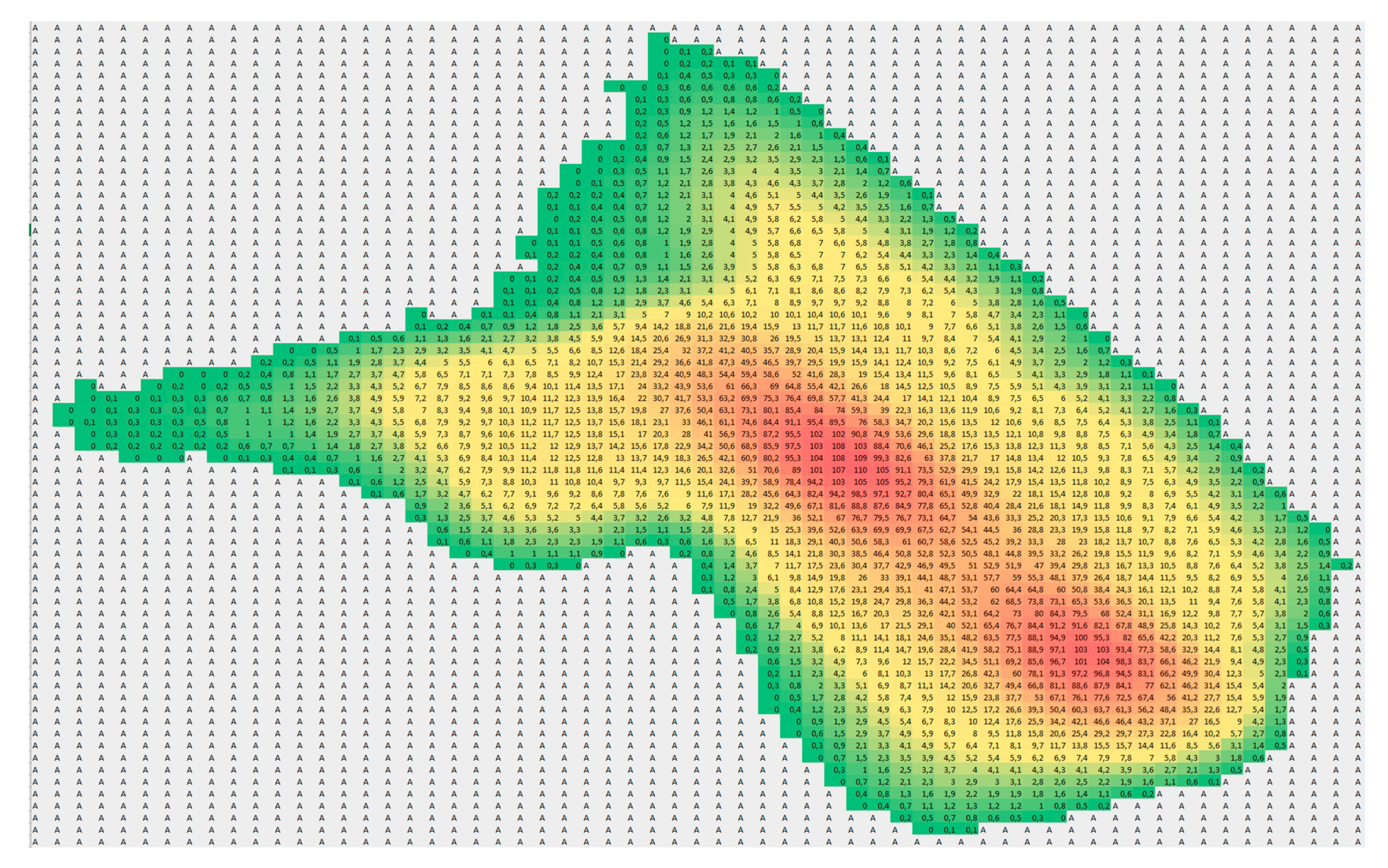

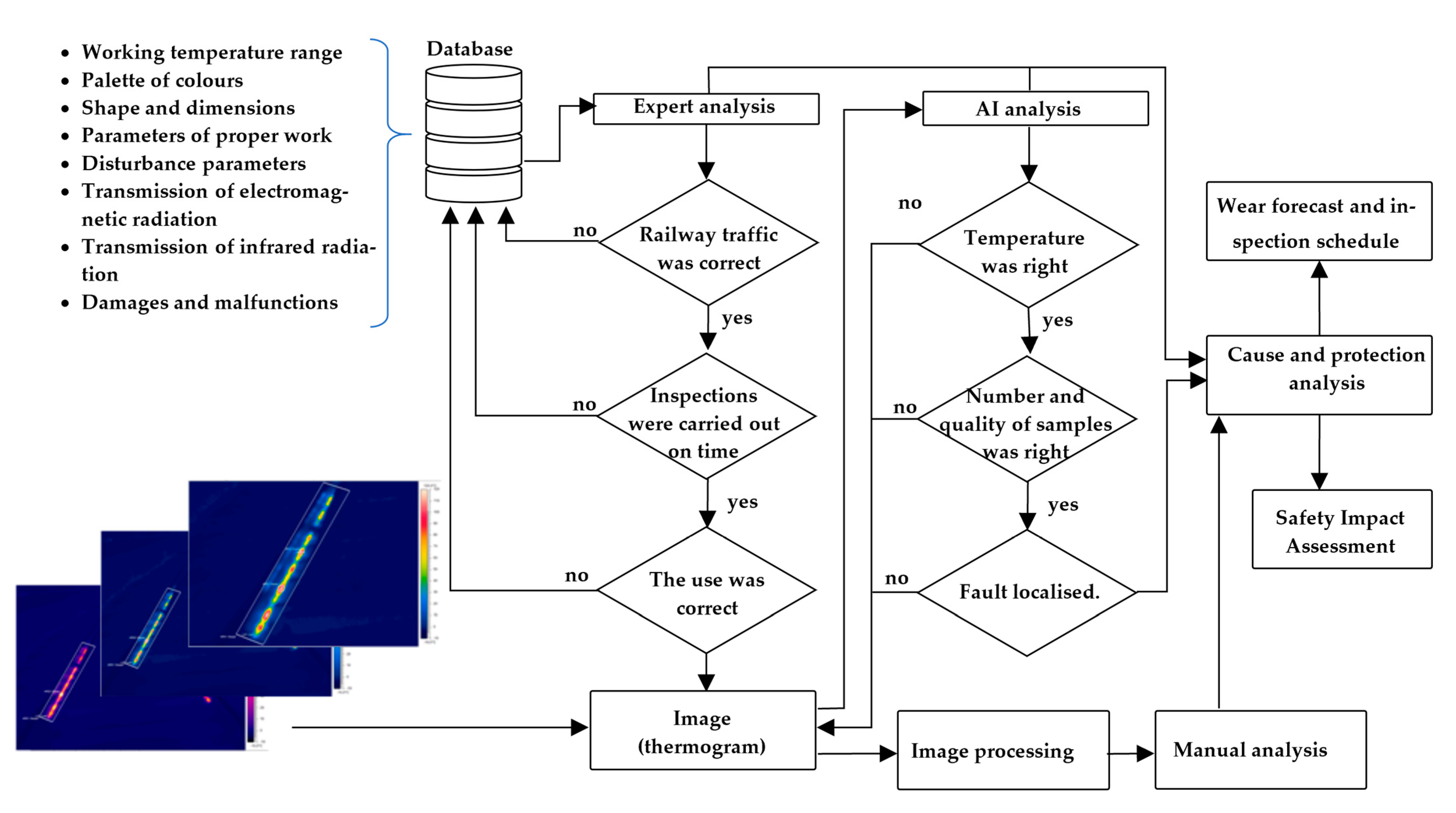
| Topics | Image Analysis | Energetic Efficiency | Diagnostics | IT Systems |
|---|---|---|---|---|
| General research/ technical requirements | [16,17,18,19,20,26,28] | [20,21,22] | [1,2,3,4,5,6,11,14,15,25] | [7,8,9,10] |
| System components/ damage | [24] | [12,13,14,37,38] | [25,29,30,39] | [23,40] |
| Modelling | [20,21,27] | [31] | [41,42] | |
| Machine learning | [34,35] | [33] | [32,36,43,44,45,46] |
| No. | Supply Voltage (V) | Nominal Rated Power (W) | Maximum Rated Power (W) | Minimum Rated Power (W) | Length L (mm) | Average Temperature with Heat Recovery | Steady-State Temperature of the Heater U = 253 V |
|---|---|---|---|---|---|---|---|
| 1. | 230 | 900 | 945 | 855 | 2800 ± 85 | >160 °C | <400 °C |
| 2. | 230 | 1050 | 1102.5 | 997.5 | 3300 ± 100 | >160 °C | <400 °C |
| 3. | 230 | 1250 | 1312.5 | 1187.5 | 3800 ± 115 | >160 °C | <400 °C |
| 4. | 230 | 1600 | 1680 | 1520 | 4800 ± 145 | >160 °C | <400 °C |
| 5. | 230 | 900 | 945 | 855 | 2800 ± 85 | >160 °C | <400 °C |
| No. | Name of the Device: Measuring Voltage | Type of Measurement | Technical Requirements | Frequency of Performance |
|---|---|---|---|---|
| 1. | Systems with rated voltage up to 1 kV, weather robots, and control panels in metal housings Up = 1000 V | 1. insulation resistance measurement | (a) R ≥ 1000 Ω/1 V for systems constructed before 07.08.1994 | s |
| 2. Checking the operation of the anti-shock protection measures | (b) R ≥ 0.5 M Ω for systems constructed (upgraded) from 08.08.1994 | Once every 5 years | ||
| 2. | EOR switchboard: Up = 500 V | 1. Checking the operation of the anti-shock protection measures | In accordance with the regulations on protection against electric shock | Once a year |
| 2. Measurement of insulation resistance of switchgear to reference earth | R > 2 M Ω | Once every 5 years | ||
| 3. Measuring the resistance between the metal casing and the reference earth | R > 20 Ω—for direct rail connection | |||
| R ≤ 20 Ω—for open rail connection | ||||
| 4. Measurement of earthing (protective earthing, working earthing of distribution point) | In accordance with the regulations on protection against electric shock | |||
| 5. Thermovision inspection | Active (operational) EOR system, thermograms of switch cabinet equipment | Once a year | ||
| 3. | EOR Transformer: - rectangular core Up = 500 V - toroidal core Up = 2.5 kV | 1. Measurement of the insulation resistance between the live parts (primary and secondary windings) | R >5 M Ω | Once a year |
| 2. Insulation resistance measurement between live parts and the power transformer box casing (applies to metal casings only) | ||||
| 4. | Heaters for heating: - resistors, - setting closures, - crossings with movable points Up = 500 V | 1. Resistance measurement | In accordance with Table 8 in [29] | Before development |
| 2. Insulation resistance measurement between joined supply wires heater and heater jacket | R > 2 M Ω | |||
| 3. Measurement of resistance between the protection wire and the heater jacket | R\le 0.1 Ω | |||
| 4. Thermovision inspection | Active (operational) EOR system, radiator thermograms | After installation and once a year | ||
| 5. | Power and control cables Up = 2.5 kV | Insulation resistance measurement | In accordance with attachments nos. 10, 11, 12 [29] | Once every 5 years |
| 6. | Turnout, area of effective influence of EOR heaters | Thermovision inspection | Active (operational) EOR system, radiator thermograms | Once a year and after: (a) Installation, (b) Maintenance |
| Sensor Type | Format Form | Characteristics |
|---|---|---|
| Thermal Imaging | 2-dimensional image of heat emission | Shape (perimeter/field, aspect ratio, geometric moments) Texture, emission max/min, number and distribution of hot spots, thermal contrast |
| TV | 2-dimensional image | Shape, texture, internal structure, contrast |
Publisher’s Note: MDPI stays neutral with regard to jurisdictional claims in published maps and institutional affiliations. |
© 2021 by the authors. Licensee MDPI, Basel, Switzerland. This article is an open access article distributed under the terms and conditions of the Creative Commons Attribution (CC BY) license (https://creativecommons.org/licenses/by/4.0/).
Share and Cite
Stypułkowski, K.; Gołda, P.; Lewczuk, K.; Tomaszewska, J. Monitoring System for Railway Infrastructure Elements Based on Thermal Imaging Analysis. Sensors 2021, 21, 3819. https://doi.org/10.3390/s21113819
Stypułkowski K, Gołda P, Lewczuk K, Tomaszewska J. Monitoring System for Railway Infrastructure Elements Based on Thermal Imaging Analysis. Sensors. 2021; 21(11):3819. https://doi.org/10.3390/s21113819
Chicago/Turabian StyleStypułkowski, Krzysztof, Paweł Gołda, Konrad Lewczuk, and Justyna Tomaszewska. 2021. "Monitoring System for Railway Infrastructure Elements Based on Thermal Imaging Analysis" Sensors 21, no. 11: 3819. https://doi.org/10.3390/s21113819
APA StyleStypułkowski, K., Gołda, P., Lewczuk, K., & Tomaszewska, J. (2021). Monitoring System for Railway Infrastructure Elements Based on Thermal Imaging Analysis. Sensors, 21(11), 3819. https://doi.org/10.3390/s21113819







